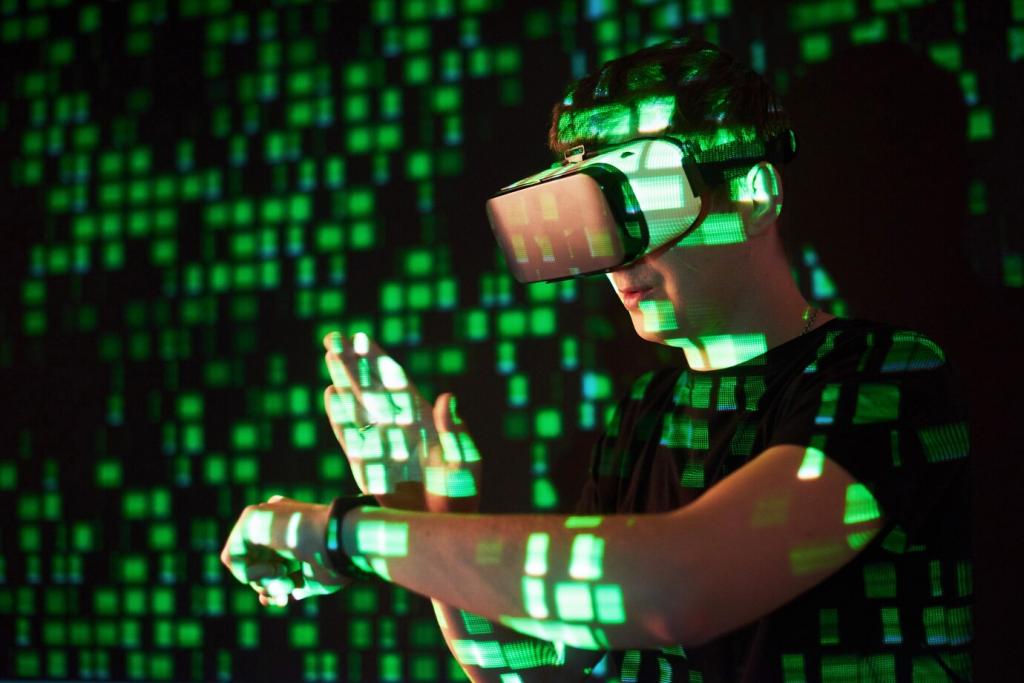Smart Technology Transforming Modern Interior Spaces
Modern interior design is experiencing a dramatic shift as smart technology becomes increasingly integrated into our everyday environments. The lines between function, comfort, and innovation are blurring, with homeowners and designers alike embracing technological advancements that redefine how we experience our personal and professional spaces. Smart solutions now deliver unprecedented convenience, personalized ambiance, and improved efficiency, ensuring interiors are not only aesthetically pleasing but also deeply functional. This seamless convergence of design and technology is transforming the way we live, work, and interact with our surroundings.

Intelligent Lighting Integration
Personalized Mood Lighting
Personalized mood lighting allows users to tailor the ambiance of a room according to their needs or emotions. With customizable color temperatures and dimming options, residents can instantly transform their space from energetic and vibrant for social gatherings to calm and soothing for relaxing evenings. Integration with voice assistants or smartphone apps further enhances customization, letting occupants control brightness and hue settings remotely or through simple voice commands. This level of personalization turns lighting into a key feature of daily comfort and well-being, maximizing satisfaction for everyone in the household.
Automated Lighting Controls
Automation has made lighting smarter than ever, with sensors and timers that automatically adjust illumination levels throughout the day. Motion detectors turn lights on only when movement is detected, ensuring spaces are well-lit when needed and conserving energy otherwise. Circadian rhythm syncing enables interior lighting to mimic natural sunlight patterns, promoting better sleep and productivity by aligning artificial lighting with our biological clocks. These automated systems are not only convenient but also contribute to significant energy savings.
Energy-Efficient Smart Bulbs
Energy-efficient smart bulbs have become a staple of modern interiors, integrating seamlessly into both contemporary and classic design schemes. These bulbs use LED technology to provide powerful illumination while consuming a fraction of the energy of traditional bulbs. Many are compatible with major smart home platforms, enabling remote monitoring and management from anywhere in the world. Not only do these bulbs reduce environmental impact and energy bills, but they also offer extended lifespans, making them a practical and sustainable choice for today’s eco-conscious consumers.
Connected Home Climate Control
Adaptive Thermostats
Adaptive thermostats go beyond traditional programmable models by employing artificial intelligence to learn the routines and preferences of occupants. These devices monitor factors such as outside temperature, humidity, and personal schedules to make real-time adjustments, maintaining optimal conditions while saving energy when rooms are unoccupied. Over time, adaptive thermostats develop profiles that ensure each space is always at just the right temperature, balancing comfort and efficiency in a way that static systems cannot match.
Zoned Climate Solutions
Zoned climate solutions allow for precise temperature control in different areas of a home or office. By dividing interiors into multiple zones, these systems cater to varying needs across spaces, such as keeping living areas cooler in the summer while maintaining cozy bedrooms. User-friendly interfaces let residents manage each zone independently, either through mobile apps or integrated wall panels. This approach not only enhances comfort for everyone but also minimizes wasted energy, as heating or cooling is provided exactly where and when it’s needed.
Indoor Air Quality Monitors
Monitoring indoor air quality is essential for maintaining a healthy and comfortable environment, especially in urban areas or homes with limited ventilation. Smart air quality monitors continuously assess pollutants, humidity, and airborne particles, providing real-time feedback and actionable alerts. When integrated with air purifiers or HVAC systems, they can automatically activate filtration and ventilation to address any detected issues. These monitors empower occupants to breathe easier, with the added benefit of maintaining optimal climate conditions year-round.
Voice-activated systems can connect with a wide range of smart devices, from lights and thermostats to security cameras and entertainment centers. This interconnected ecosystem allows for effortless control over multiple aspects of the environment without the need for separate remotes or complicated interfaces. Residents can easily create custom routines—such as “Good Morning” or “Movie Night”—that adjust several settings simultaneously, streamlining daily transitions and personalizing the living experience.
Voice-Activated Living Spaces
Previous slide
Next slide
Automated Entertainment Environments
Integrated Audio-Visual Experiences
State-of-the-art audio and video systems are now designed to be discreet, with speakers, projectors, or screens that blend into a room’s architecture. These components can be managed from a central interface or activated by voice commands, allowing users to curate the perfect soundtrack or display with minimal effort. This integration creates an uninterrupted aesthetic and a completely immersive media experience for everything from movie nights to parties.


Dynamic Entertainment Automation
Automated entertainment systems adjust settings based on user preferences or programmed scenes. Pre-set modes can dim the lights, close the shades, and set the perfect audio volume for different types of media, whether watching a film, playing games, or hosting guests. This dynamic automation eliminates clunky remote controls in favor of streamlined, enjoyable experiences that adapt instantly to changing needs.
Space Optimization with Smart Furniture
Multi-Functional Workspaces
Hybrid living and working have prompted a surge in demand for furniture that serves multiple purposes. Smart desks with integrated power outlets, wireless charging, and concealed storage enable clutter-free productivity in even the smallest areas. These adaptable pieces can be seamlessly transformed from home offices to dining spaces or relaxation zones, providing unparalleled versatility for modern lifestyles.
Automated Storage Solutions
Closets, cabinets, and shelving systems are becoming increasingly intelligent, with features like motorized shelves, app-controlled access, or automated lighting that activates upon entry. These advances optimize storage capacity while keeping items organized and easy to find. Automated systems reduce the need for bulky furniture, making smaller interiors feel more spacious and orderly, and contributing to a visually harmonious environment.
Technology-Embedded Seating
Seating is also benefiting from smart upgrades: sofas and chairs now come with built-in speakers, adjustable lumbar support, and temperature regulation. Some models feature motorized reclining or massage functions, all controllable via smartphone apps or integrated touch panels. These advancements elevate the comfort and functionality of everyday furniture, making it possible to relax, work, or entertain in style and luxury.
Sustainable Smart Solutions
Smart Energy Management Systems
Energy consumption can be closely monitored and managed through centralized systems that track usage in real time. With insights into power-hungry devices and automated scheduling, residents can pinpoint inefficiencies and make informed changes. Some platforms also allow for remote power cycling and integration with renewable energy sources such as solar panels, paving the way for greener, more responsible living spaces.
Water Conservation Technologies
Incorporating smart water fixtures and leak detection sensors into bathrooms and kitchens makes it possible to significantly reduce water waste. Automated faucets, showers, and irrigation systems adjust flow rates based on usage patterns or environmental conditions. Prompt notifications and automatic shutoffs in the event of leaks help prevent water damage and lower utility bills, promoting a sustainable approach that merges technology with responsible resource management.
Eco-Friendly Material Tracking
Many smart interiors now feature technology that monitors the lifecycle and provenance of building materials and furnishings. Tags or sensors embedded within products facilitate recycling or responsible disposal and can even suggest maintenance schedules to extend product lifespan. Such tracking reinforces the commitment of homeowners and designers to sustainable practices, ensuring interiors are both stylish and environmentally sound.

